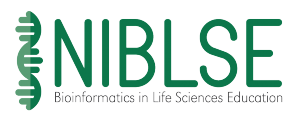Bioinformatics Learning Resources for Genetics Courses
For each resource, we indicate associated GSA topics*, bioinformatic tools, uses and constraints. Hover over each title to view the resource description. Unless otherwise noted, background knowledge and skills typically taught in introductory biology are assumed; additional prerequisites are noted within the constraints. (*Genetics Society of America Genetics Learning Framework 2015 Core Categories)
Introductory Bioinformatics
Using Bioinformatics to Understand Genetic Diseases (click to download)
- GSA Topics: Molecular Biology of Gene Function, Genetic Variation
- Bioinformatics Tools: BLAST, multiple sequence alignment, automated sequence translation, 3D protein structure, phylogenetic trees
- Why Use This? Introduction to multiple bioinformatics tools in the context of a human disease (diabetes). Each set of exercises takes only a few minutes and illustrates one or two tools. Students could try each tool on their own ‘pet gene’ if desired.
- Constraints: Answers not included with exercises, but easy to obtain by following instructions. Note: First link in first exercise is broken; instead, go to http://genome.ucsc.edu/ and click on ‘BLAT’.
Drosophila Behavioral Genetics (click to download)
- GSA Topics: Gene Expression and Regulation, Genetics of Model Organisms
- Bioinformatics Tools: Biological databases, genome browsers
- Why Use This? Accessible introduction to biological databases and genome browsers, highlights the power of genetic model organisms to study complex biological phenomena.
- Constraints: Requires two class meetings or a two-hour lab period, computers/internet access
Intermediate Bioinformatics
Sequence Similarity: Exploring Ebola Virus (click to download)
- GSA Topics: Evolution & Population Genetics
- Bioinformatics Tools: BLAST, multiple sequence alignment, phylogenetic tree building
- Why Use This? Introduction to the concept of sequence similarity, bioinformatics tools to examine it, and ‘under-the-hood’ understanding of algorithms involved; ends with a hypothesis-based small project.
- Constraints: Requires two 3-hour lab periods, paper & pencil, computers/internet access and some background knowledge in probability; may be too in-depth for first-time exposure to bioinformatics.
Advanced Bioinformatics
RNA-seq with Galaxy (click to download)
- GSA Topics: Gene Expression & Regulation
- Bioinformatics Tools: Galaxy, FastQC, Trimmomatic, Bowtie/HISAT2, DESEQ2
- Why Use This? Sophisticated command line tools for transcriptome analysis are made accessible through the Galaxy user interface. Instructors can choose from one of several pre-selected data sets or choose their own. The activity also introduces students to NCBI databases (SRA), the importance of data quality control, and the use of workflows (pipelines).
- Constraints: Requires three 3-hour lab periods; some processes (e.g., read mapping) may take hours to complete depending on genome complexity
